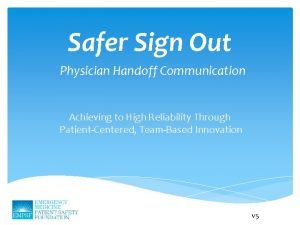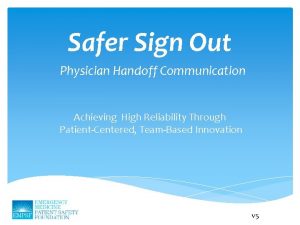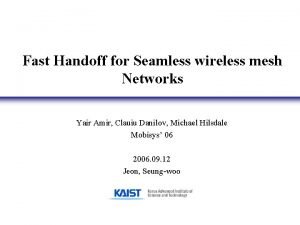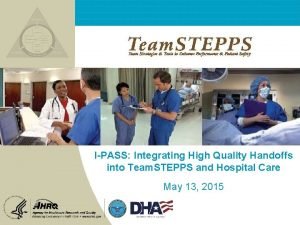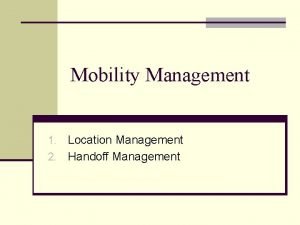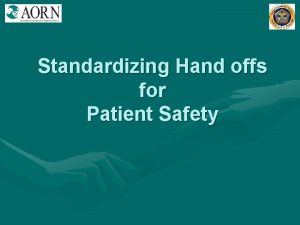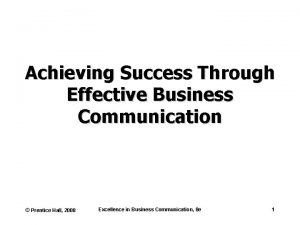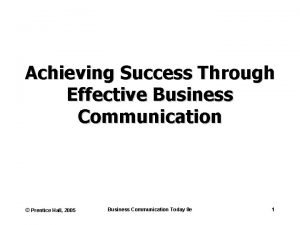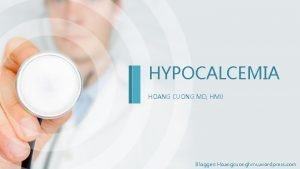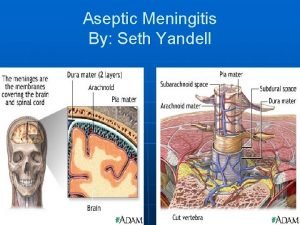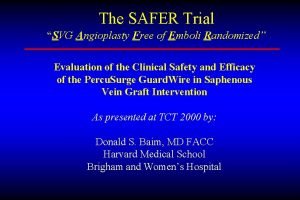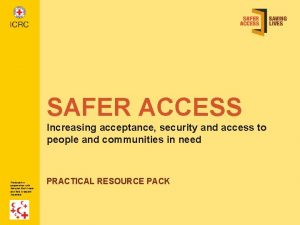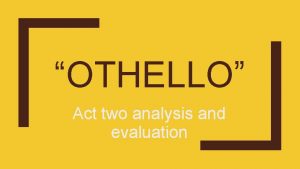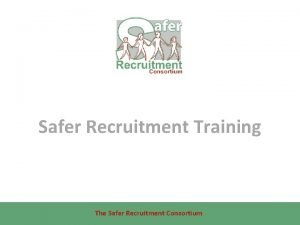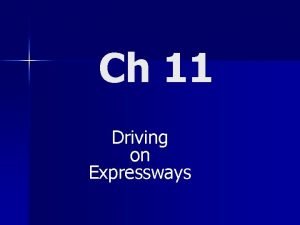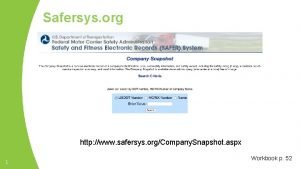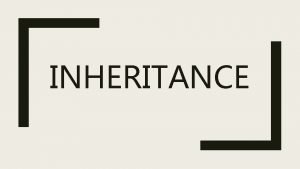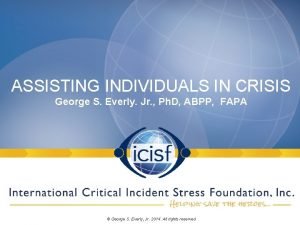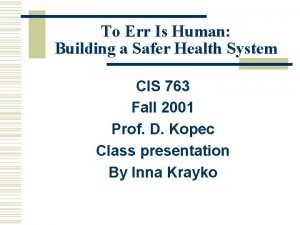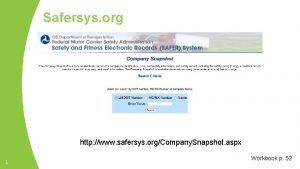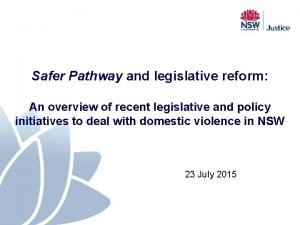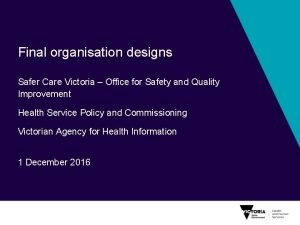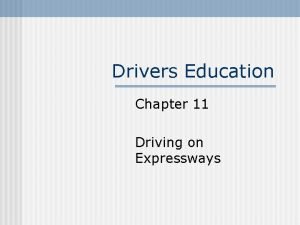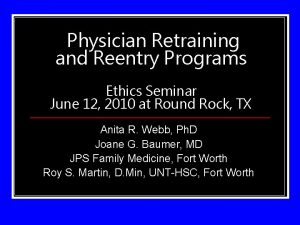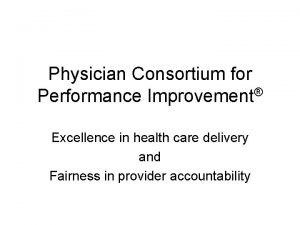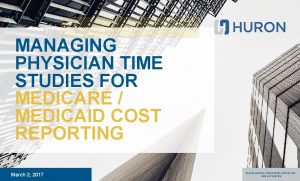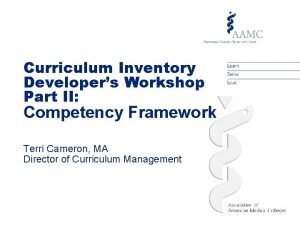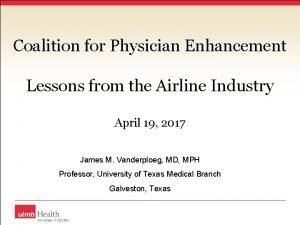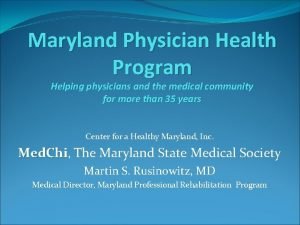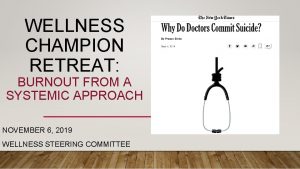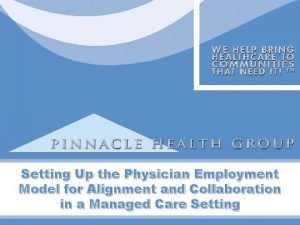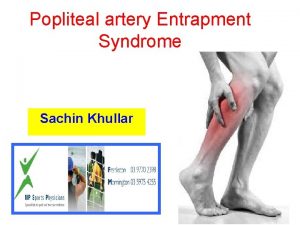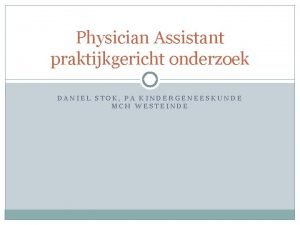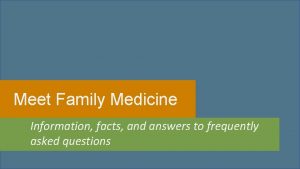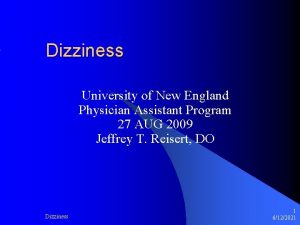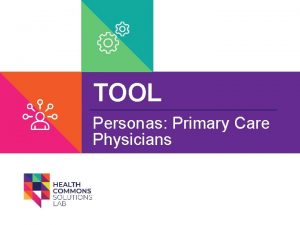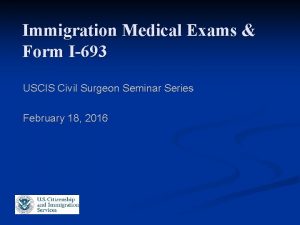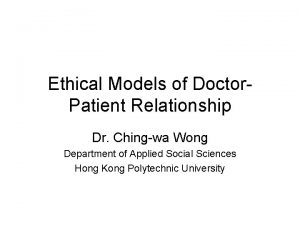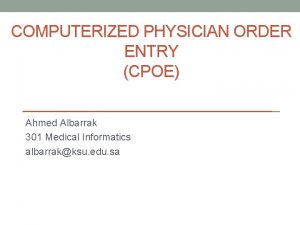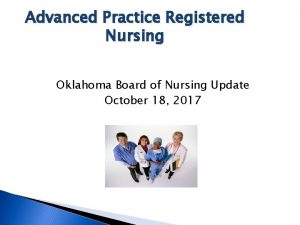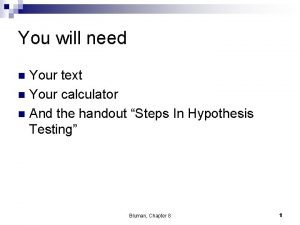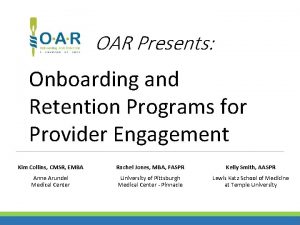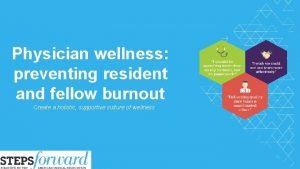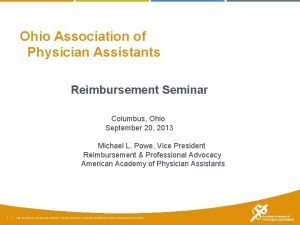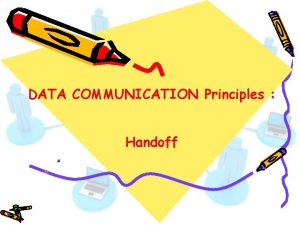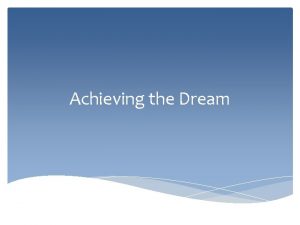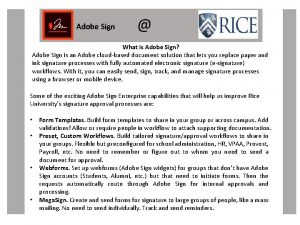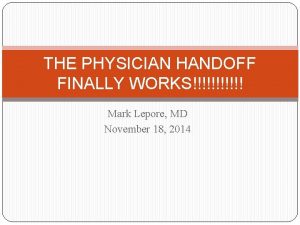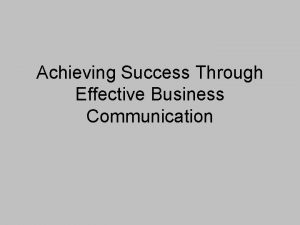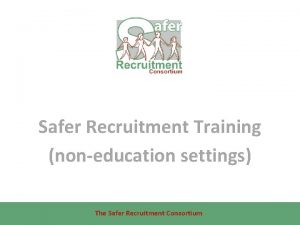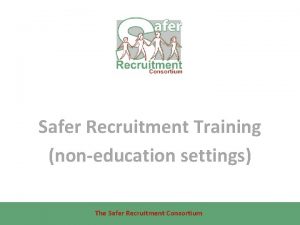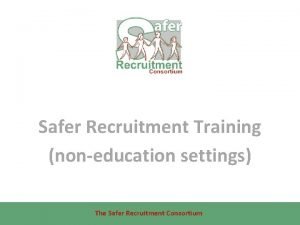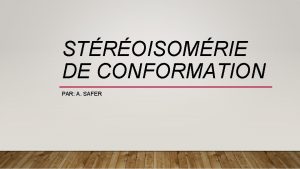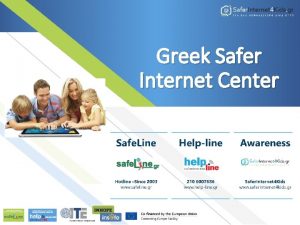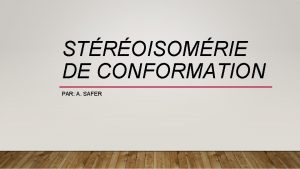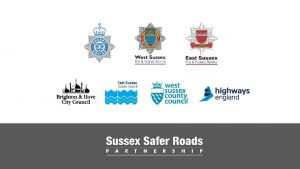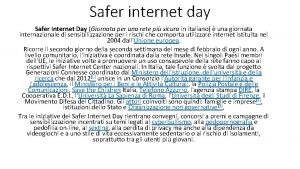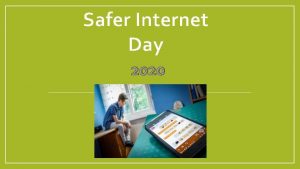Safer Sign Out Physician Handoff Communication Achieving to





























































- Slides: 61

Safer Sign Out Physician Handoff Communication Achieving to High Reliability Through Patient-Centered, Team-Based Innovation v 5

Drew C. Fuller, MD, MPH, FACEP Board of Directors / Education Committee Past Chair, Quality Improvement & Patient Safety Section (QIPS) (Synergy Interest) Director of Safety Innovation

Safer Sign Out • Patient Centered • Team Based • Risk-Focused • Physician (Frontline) Developed • Method for Structured Physician Handoffs

National Patient Safety Goal 2 E (2006) Standardization of Handoff Communication

“Sign out is the most dangerous procedure in the Emergency Department” Charles “Chaz” Schoenfeld, MD (1950 -2010)

Why Structure? • Up to 80% of serious medical errors involve miscommunication during handoffs (TJC) Up to 24% ED malpractice claims related to handoff (Cheung 2010)

Progress • Nursing profession – Leading with Models/Methods • Few Physician Models

Emergency Departments - High Risk ED Factors – Potentiate Errors • • • Production/Time Pressure High Noise Levels High Acuity Multitasking Time Sensitive Conditions Rapid Turnover Frequent Interruptions New/Unknown Patients Undifferentiated Diagnosis Wide Clinical Variation Increasing Complexity

Handoffs - High Risk Points of Potential Failure • • • Neglected/Missed Information Unclear Transfer of Responsibility Team Unaware of Transfer/Issues Patient/Family Unaware Change in Status Lack of Mechanism for QA

Why Structure is Critical High Risk Process + High Risk Environment Mandates High Reliability

High Reliability • Structured • Workable • Predictable • Measurable

Industries Committing to High Reliability

Pilots Committed to Standardized Communication

“Quick” Handoff Practice (Click on Photo to Start Video)

Name that Handoff Hit & Run?

“Typical” Handoff Practice (Click on Picture to Start Video)

Name that Handoff “Hopeful Handoff”

What’s Missing? Typical ‘Hopeful’ Handoff • Critical items conveyed? • Safeguards? (Checklist? ) • Current clinical status? • Patient aware/Involved? • Nurse aware/involved? • QA ?

Hope Model for Safety • Hope nothing goes wrong • Safe By Luck or Design? • Unstructured – No Standard • Not High Reliability (High Vulnerability) • Poor Strategy for Safety

Designing a Better Way • Focus on areas of RISK • Practical implementation • Scalable • WORK for Clinicians

EMA Safety Leadership Group Physician Representation 12 Hospital/Clinical Sites: Maryland Virginia Washington, DC West Virginia

American College of Emergency Physicians (ACEP) Quality Improvement & Patient Safety (QIPS) • White Paper on Improving Handoffs by Dickson Cheung, Jack Kelly et al • 20 National Clinical & Safety Experts • Recommendations for Best Practice

Frontline Input • Sign Out Safety Survey • 104 ED Physicians & 50 PAs • Directors’ Guidance • ACEP QIPS leaders • Executive Input • Nursing Input & Feedback

“The Essential Connections” Physician to Physician Patient/Family Nurse (Team)

Key Components Safer Sign Out 1) Record - Critical Data & Pending Items 2) Review - Form & Computer Data 3) Round – Bedside, Together 4) Relay to the Team – Nurse Collaboration ___________________________________________________ 5) Receive Feedback – Clinical/QA

1) Record Use a Recordable Form • Clear transfer of responsibility • Prompts to identify Key items • Checklist & Reference Tool


Back of Sign Out Form (Reinforces Protocol)

2) Review Joint Focus - Form & Data • Done at a computer Access to lab/rad results • Assure Shared Understanding Purposeful time for Q & A

3) Round - Bedside Round - Together • Status -“Eyes on the patient” • Introduction/Update • Team Communication

4) Relay to the Team Communicate with the Nurse – Transition/Updates • Opportunity for input/feedback • Assures team understanding • Before, during or after rounds

5) Receive Feedback Form as a Feedback Tool • Clinical Follow Up • Quality Assurance Tool

Quality Assurance ✔ ✔ Built-in tool to help with QA

Initial Hospital Sites

Initial SSO Development Team • • • • • Don Infeld, MD (EMA President) Jackie Pollock, CEO (EMA) Nicole Bergen, Dir. of Op. (EMA) Martin Brown, MD, CMO (EMA) John Schnabel, MD Chris Morrow, MD Tim Hsu, MD Richard Ferraro, MD Karla Lacayo, MD Cameron Cushing, MD Michael Kerr, MD Steven Smith, MD David Jacobs, MD Jennifer Abele, MD Drew White, MD, MBA Michael Silverman, MD Marney Treese, MD • • • • Justin Green, MD Napoleon Magpantay, MD Kurt Rodney, MD Sora Chung, MD Matt Sasser, MD Jon D’Souza, MD Todd Larson, MD Junior Williams, MD Larry Mack-Wilson, PA-C Eric Parvis, MD Chris Morrow, MD Kala Scoggin, PA-C Elizabeth Cook Drew Fuller, MD, MPH Kilole Kanno, MD Nadia Eltaki, MD

Rapid Cycle Improvement

What We Learned • Physician Champions (Key) • Ease of implementation • Educate & support • Initial resistance resolves • Use QA to sustain

Engaging Physicians “Protect Your Patients, Support Your Colleagues” • Appeal to their interest • Performance => how it ’Occurs’ to them • Listen, support & reassure

Understanding Adoption

Readiness for Change “Start Where They Are”

Physician Feedback “ This is so much better than what we use to do” “ I was initially resistant but now I get it” “I sleep better at night”

Committed to Collaboration • Share the Process • Teach Others • Seek Understanding • Pursue Refinement • Regionally/Nationally

American College of Emergency Physicians (ACEP) Quality Improvement & Patient Safety Section Website First Featured Safety Project

Emergency Medicine Patient Safety Foundation (EMPSF) • Voice for Safety in Emergency Medicine • National Collaborator • SSO Flagship Safety Tool • Dedicated SSO Website • Consultation Service

Safer. Sign. Out. com Toolkit (Web-based) • • • Education Downloads Forms Posters Strategy/Best Practices Videos & More

Logo

AMA Handoff Resource Listing • Handoff Resource (RFS) • Description and links to Safer. Sign. Out. com

AMA Handoff Resource Listing • Handoff Resource (RFS) • Description and links to Safer. Sign. Out. com

Agency for Healthcare Research & Quality (List Safer. Sign. Out. com as a Resource)

SSO in the Press

SSO in the Press

Educational/Promotional Poster

ABEM MOC PI Tool • Help your physicians meet their MOC PI requirement • Easily Utilized • To be featured on ACEP’s Handoff education tool

Collaborative Synergistic Innovation (CSI) • Model for Innovation • Open Resource • Clinician Driven • Best Practice Refinement • Supports Research, Distribution, Education

Innovation Partners Leading the Way YOU

Getting Started 1, 2, 3. . . 1. 2. 3. 4. 5. Use EMPSF as a resource Enlist “Champions” Build the case for a structured method Launch as a Team based approach Monitor the process & give feedback

Atul Gawande "Better is possible. It does not take genius. It takes diligence. It takes moral clarity. It takes ingenuity. And above all, it takes a willingness to try. ”

Make the Commitment 1963 Speech at NASA Throw Your Hat Over the Wall

SSO “Stand Up for Safety” Video https: //vimeo. com/65199210

We Stand Committed to Safety

Further Information Dianne Vass Drew Fuller, MD, MPH, FACEP Executive Director Emergency Medicine Patient Safety Foundation (EMPSF) Folsom, California Director of Patient Innovation Emergency Medicine Associates, PA, PC Germantown, Maryland EMAOnline. com Dvass@EMPSF. org Drewfuller@mac. com
 Physician sign out
Physician sign out Safer sign out
Safer sign out Mesh wifi handoff
Mesh wifi handoff Ipass handoff examples
Ipass handoff examples Network controlled handoff
Network controlled handoff 5 p's of patient handoff
5 p's of patient handoff Sign sign everywhere a sign
Sign sign everywhere a sign One thing one direction
One thing one direction Competing messages communication barriers
Competing messages communication barriers Achieving success through effective business communication
Achieving success through effective business communication Cuong nguyen md
Cuong nguyen md Trusso sign
Trusso sign Chvostek sign trousseau sign
Chvostek sign trousseau sign Kernig and brudzinski signs
Kernig and brudzinski signs Same signs add and keep
Same signs add and keep Safer trial
Safer trial 8 elements of safer access
8 elements of safer access Where are we as act 2 begins
Where are we as act 2 begins Engineering a safer world
Engineering a safer world Safer recruitment consortium
Safer recruitment consortium Maybo safer model
Maybo safer model Characteristics of expressway driving
Characteristics of expressway driving Safetsys
Safetsys Single level inheritance is safer than
Single level inheritance is safer than Engineering a safer world
Engineering a safer world Safer modell
Safer modell To err is human: building a safer health system
To err is human: building a safer health system Www.safersys.org
Www.safersys.org Safer web mc
Safer web mc It stops here safer pathway
It stops here safer pathway Safer care victoria
Safer care victoria Self-driving coalition for safer streets
Self-driving coalition for safer streets Safer places scheme
Safer places scheme Chapter 11 driving on expressways
Chapter 11 driving on expressways A physician claims that joggers maximum volume
A physician claims that joggers maximum volume Physician reentry program
Physician reentry program Physician consortium for performance improvement
Physician consortium for performance improvement Physician time studies
Physician time studies Presciber segmentation
Presciber segmentation Physician competency reference set
Physician competency reference set Coalition for physician enhancement
Coalition for physician enhancement Jeannie watkins
Jeannie watkins Prayers against monitoring spirits elisha goodman
Prayers against monitoring spirits elisha goodman Maryland physician health program
Maryland physician health program Physician burnout retreat
Physician burnout retreat Physician employment models
Physician employment models Sports physician sachin khullar
Sports physician sachin khullar Werkplekleren epa
Werkplekleren epa Family medicine procedures
Family medicine procedures University of new england physician assistant program
University of new england physician assistant program Physician personas
Physician personas Uscis surgeon locator
Uscis surgeon locator Doctor-patient relationship ethics
Doctor-patient relationship ethics Computerized physician order entry definition
Computerized physician order entry definition Oklahoma board of nursing supervising physician
Oklahoma board of nursing supervising physician A physician claims that joggers maximum volume
A physician claims that joggers maximum volume Onboarding portal upmc
Onboarding portal upmc The good physician treats the disease
The good physician treats the disease Wellstar physicians
Wellstar physicians Stanford physician wellness survey
Stanford physician wellness survey Pricewaterhouse
Pricewaterhouse Pa ieb physician certification form
Pa ieb physician certification form
